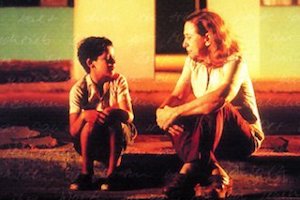Following Foreign Film: “Central Station”

Josué and Dora on the poster for “Central Station”
July 23, 2017
This time, I looked to the other side of the globe: “Central do Brasil,” “Central Station” in English, a 1998 Brazilian movie that was nominated for Academy Awards in the Best Foreign Language Film and Best Actress categories. Brazilian cinema has a rich history, its most notable movement being Cinema Novo, which was popular in the 1960s and 1970s. This style has similar aesthetic features to French New Wave cinema, and involves displaying life in a more realistic manner, rejecting the previous Hollywood-esque and comedic films Brazil had formerly produced- even containing political commentary. In the 1990s, filmmakers once again took influence from Cinema Novo, including Walter Salles, “Central Station’s” director.
“Central Station” follows a young boy named Josué (Vinícius de Oliveira) and a retired teacher named Dora’s (Fernanda Montenegro) journey to find Josué’s father. Dora currently works at Rio de Janeiro’s Central Station as a letter writer for illiterate people, where she doesn’t bother to mail many letters, when she meets Josué and his mother Ana (Soia Lira), who write a letter to Josué’s estranged father. However, Ana dies soon after, and Dora decides to take Josué under her wing to find his father.
The friendship between Josué and Dora develops gradually, as they don’t like each other at the beginning of the movie. As time progresses, through many comedic moments, we can see the two characters- both stubborn in their own ways- recognize that they have helped change each other and grow. Montenegro conveyed this journey with nuance, and her final words in the film were affecting.
Even before Montenegro’s acclaimed performance, the first thing I noticed while watching “Central Station” was its cinematography. It was simple, with few elaborately placed camera angles, unlike the more dramatic tone-setting cinematography in “In the Mood for Love.” I enjoyed viewing the wide shots, from people bustling about in the Central Station to rows upon rows of houses in crowded neighborhoods. Then there were the satisfyingly symmetrical shots, with subjects placed right in the center.
Christian imagery is prevalent throughout “Central Station,” and while the main theme of the movie being religious can be argued either way, the film does depict a part of the role religion plays in the predominantly Catholic country.
“Central Station” illustrated an odyssey of characters finding parts of their identities. For Josué, this was his father, and for Dora, this was her seeing the importance that the letters she wrote have to other’s identities. This film will make for an enjoyable watch for viewers looking for a quiet charm or content they can dig into and analyze.





